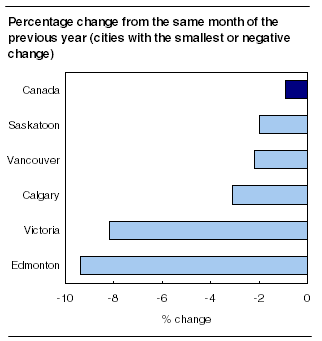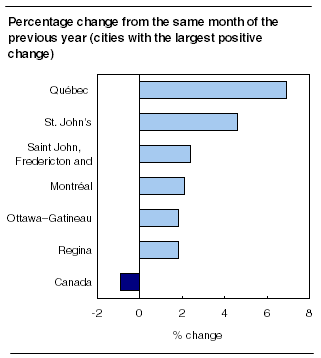Common menu bar links
New Housing Price Index
Archived Content
Information identified as archived is provided for reference, research or recordkeeping purposes. It is not subject to the Government of Canada Web Standards and has not been altered or updated since it was archived. Please "contact us" to request a format other than those available.
Related subjects
The New Housing Price Index rose 0.4% in December, the same increase as reported in November.
Between November and December, prices rose the most in Ottawa–Gatineau (+0.8%), followed by St. John's, Toronto and Oshawa, as well as Vancouver, which all registered 0.7% increases.
In Ottawa–Gatineau, the increase in prices was attributable to good market conditions and competitive factors. In St. John's, prices rose as builders reported increased material and labour costs.
In Toronto and Oshawa, price increases were due to several builders revising the value of their models and adjusting their prices upwards as well as to stronger market conditions. In Vancouver, builders continued to increase their prices as consumer interest remained strong.
Of the 21 metropolitan areas surveyed, only Calgary and Victoria (both down 0.2%) recorded decreases in new housing prices.
In Calgary, some builders moved to new phases of development with lower priced lots.
Lower negotiated selling prices contributed to the decrease of new housing prices in Victoria.
Year over year, the New Housing Price Index was down 0.9% in December, compared with the 1.4% decline registered in November. Western Canada remained the main contributor to the decrease in the total new housing price index.
On the Prairies, 12-month declines were recorded in Edmonton (-9.4%), Calgary (-3.1%) and Saskatoon (-2.0%).

Year-over-year declines were also reported in Victoria (-8.2%) and Vancouver (-2.2%).
Once again, the largest year-over-year increase was registered in Québec (+6.9%). Higher residential land values remained the primary reason for the increase.
On a year-over-year basis, prices were also up in St. John's (+4.6%), Saint John, Fredericton and Moncton (+2.4%) and Montréal (+2.1%). Contractors' selling prices were also higher in Ottawa–Gatineau and Regina, with both registering year-over-over increases of 1.8%.

Available on CANSIM: table 327-0005.
Definitions, data sources and methods: survey number 2310.
The fourth quarter 2009 issue of Capital Expenditure Price Statistics (62-007-X, free) will be available in April.
For more information, or to enquire about the concepts, methods or data quality of this release, contact Client Services (613-951-4550; toll-free 1-888-951-4550; fax: 613-951-3117; ppd-info-dpp@statcan.gc.ca), Producer Prices Division.
Table 1
| 2009 | December 2008 | November 2009 | December 2009 | November to December 2009 | December 2008 to December 2009 | |
|---|---|---|---|---|---|---|
| relative Importance1 | (1997=100) | % change | ||||
| Canada total | 100.00 | 157.4 | 155.4 | 156.0 | 0.4 | -0.9 |
| House only | .. | 165.5 | 164.0 | 164.9 | 0.5 | -0.4 |
| Land only | .. | 141.0 | 137.9 | 137.8 | -0.1 | -2.3 |
| St. John's | 1.05 | 177.6 | 184.4 | 185.7 | 0.7 | 4.6 |
| Charlottetown | 0.27 | 119.4 | 120.4 | 120.4 | 0.0 | 0.8 |
| Halifax | 1.14 | 150.3 | 151.1 | 151.1 | 0.0 | 0.5 |
| Saint John, Fredericton and Moncton2 | 0.95 | 118.3 | 121.1 | 121.1 | 0.0 | 2.4 |
| Québec | 2.26 | 159.4 | 170.4 | 170.4 | 0.0 | 6.9 |
| Montréal | 10.15 | 163.7 | 166.8 | 167.1 | 0.2 | 2.1 |
| Ottawa–Gatineau | 4.30 | 169.6 | 171.4 | 172.7 | 0.8 | 1.8 |
| Toronto and Oshawa2 | 35.30 | 146.4 | 147.0 | 148.0 | 0.7 | 1.1 |
| Hamilton | 2.82 | 152.4 | 151.0 | 151.0 | 0.0 | -0.9 |
| St. Catharines–Niagara | 1.09 | 155.6 | 157.4 | 157.4 | 0.0 | 1.2 |
| London | 2.12 | 143.3 | 145.1 | 145.1 | 0.0 | 1.3 |
| Kitchener | 2.14 | 143.2 | 143.8 | 143.8 | 0.0 | 0.4 |
| Windsor | 0.82 | 103.7 | 104.0 | 104.0 | 0.0 | 0.3 |
| Greater Sudbury and Thunder Bay2 | 0.82 | 112.7 | 112.6 | 112.6 | 0.0 | -0.1 |
| Winnipeg | 1.46 | 181.4 | 183.5 | 184.1 | 0.3 | 1.5 |
| Regina | 0.58 | 248.7 | 253.1 | 253.1 | 0.0 | 1.8 |
| Saskatoon | 0.71 | 218.1 | 213.0 | 213.7 | 0.3 | -2.0 |
| Calgary | 7.68 | 240.7 | 233.6 | 233.2 | -0.2 | -3.1 |
| Edmonton | 8.28 | 228.7 | 207.0 | 207.3 | 0.1 | -9.4 |
| Vancouver | 14.21 | 120.6 | 117.2 | 118.0 | 0.7 | -2.2 |
| Victoria | 1.85 | 115.6 | 106.3 | 106.1 | -0.2 | -8.2 |

